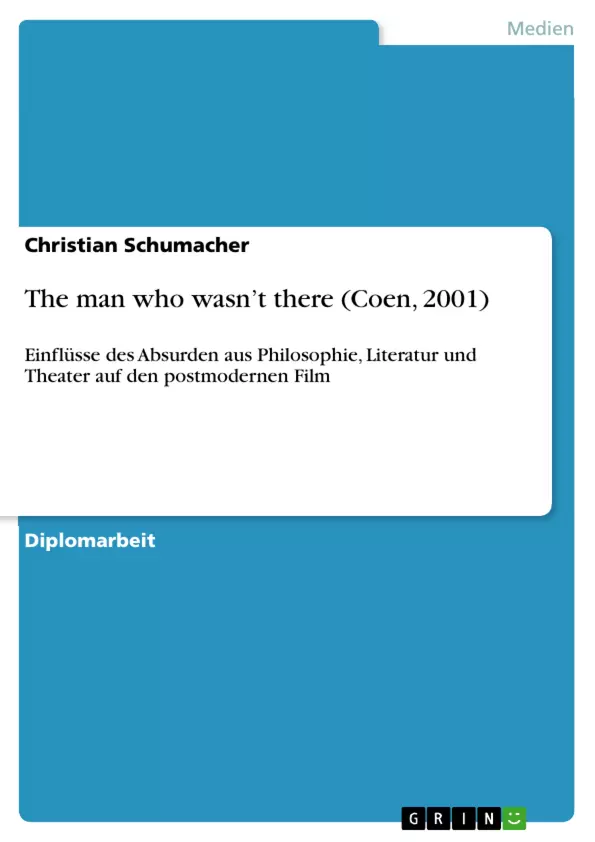Die Arbeit untersucht mittels einer Filmanalyse von THE MAN WHO WASN’T THERE (Coen, 2001), inwieweit Einflüsse des Absurden auf den postmodernen Spielfilm zu erkennen sind.
Inhaltsverzeichnis
- ABKÜRZUNGSVERZEICHNIS
- EINLEITUNG
- 1 DER BEGRIFF DES ABSURDEN IN DER PHILOSOPHIE
- 1.1 LEXIKALISCHE UND PHILOLOGISCHE ANNÄHERUNG
- 1.2 ONTOLOGISCHE DEUTUNG
- 1.2.1 Das Absurde zwischen Religion und Existentialismus
- 1.2.2 Glauben weil es absurd ist (Kierkegaard)
- 1.2.3 Der Verlust metaphysischen Sinns (Nietzsche)
- 1.2.4 Die absurden Mauern (Camus)
- 1.3 DIALEKTISCHE DEUTUNG
- 1.3.1 Aufklärung als Absurdität
- 1.3.2 Der moderne Mensch
- 1.4 AMBIVALENTE BEGRIFFSWELT: GRENZEN DER SPRACHE
- 1.5 DAS ÄSTHETISCHE PRINZIP UND DIE MUSIK
- 2 DAS ABSURDE IN LITERATUR UND THEATER
- 2.1 ANFÄNGE UND ENTWICKLUNG
- 2.1.1 Das Tragisch-Absurde: Shakespeare & der Manierismus
- 2.1.2 Die vielfältigen Formen des Absurden
- 2.1.3 Franz Kafka – die Verkörperung des Absurden
- 2.2 DAS EXISTENTIALISTISCH-ABSURDE
- 2.2.1 Indifferenz – Niedergang von Subjekt und Erzählung
- 2.2.2 Das Absurde als das Unberechenbare bei Sartre
- 2.2.3 Objektivierung der Handlung bei Camus
- 2.3 DAS THEATER DES ABSURDEN
- 2.3.1 Bildungskultur ad absurdum
- 2.3.2 Reduktion von Handlung und Figuren
- 2.3.3 Sprachentwertung
- 2.3.4 Der Sinn des Absurden
- 3 DAS ABSURDE IM FILM
- 3.1 DIE LÄCHERLICHKEIT DES MODERNEN MENSCHEN
- 3.1.1 Chaplin, Keaton und die Stummfilmkomödie
- 3.1.2 Kubricks Komödie der Selbstvernichtung
- 3.2 ABSURDE TENDENZEN IM EUROPÄISCHEN KINO
- 3.2.1 Verdinglichung und Stillstand bei Antonioni
- 3.2.2 Die Nouvelle Vague bricht mit der klassischen Erzählung
- 3.2.3 Jean-Luc Godards Spiel mit filmischen Zeichen und Sinn
- 3.2.4 Zufall und Sinnestäuschung bei Buñuel
- 3.2.5 Skandinavische Absurde: Befreiung und Groteske
- 3.3 ROMAN POLANSKIS ABSURDE GENRE-PARODIEN
- 3.4 KRITERIENERSTELLUNG FÜR DIE FILMANALYSE
- 3.4.1 Zwischen Tragödie, Komödie und Existentialismus
- 3.4.2 Der gleichgültige Held
- 3.4.3 Kunst und insbesondere Musik als Fluchtmöglichkeit
- 3.4.4 Sprachentwertung
- 3.4.5 Zufälligkeit und Verkehrung der Handlung
- 3.4.6 Subjektverlust und Schuldmotiv
- 3.4.7 Subtile Dekonstruktion von Wirklichkeit
- 3.4.8 Demontage der Mythen
- 3.4.9 Verweigerung einer eindeutigen Sinnvorgabe
- 4 EINORDNUNG DES COEN-WERKES
- 4.1 RAUM FÜR IRRITATIONEN – BIOGRAPHISCHES
- 4.2 ZUM BEGRIFF DER POSTMODERNE
- 4.2.1 Auf den Spuren von Nietzsche, Kafka, Beckett
- 4.2.2 Funktionalität statt Sinnproduktion
- 4.2.3 Zur Differenzierung filmischer Selbstreferentialität
- 4.2.4 Die Coens thematisieren die Oberflächenlogik
- 4.3 IM ZEICHEN DES ABSURDEN: DAS WERK DER COENS
- 4.3.1 Der absurde Held
- 4.3.2 Kafkaeske Konstruktionsmuster
- 4.3.3 Im Labyrinth der Zeichen
- 4.3.4 Demontage der Mythen
- 4.3.5 Der verhinderte Autor
- 4.3.6 Auflösung der Wirklichkeit
- 4.3.7 „Am Randes des Nichts“: Verweigerte Sinnvorgabe
- 5 FILMANALYSE: THE MAN WHO WASN’T THERE
- 5.1 PRODUKTIONSNOTIZEN
- 5.2 STRUKTUR UND SYNOPSIS
- 5.3 PRÜFUNG DER KRITERIEN DES ABSURDEN
- 5.3.1 Tragik-Komische Annäherung: Die absurde Perspektive
- 5.3.2 Kausale Annäherung: Im Strudel des Irrationalen
- 5.3.3 Selbstreferentielle Annäherung: Nur scheinbar ein Noir
- 5.3.4 Existentielle Annäherung: Der gleichgültige Held
- 5.3.5 Sprachkritische Annäherung: Worte ohne Sinn
- 5.3.6 Musische Annäherung: Flucht in die Musik
- 5.3.7 Fatalistische Annäherung: Verdinglichte Schuld
- 5.3.8 Subjektivistische Annäherung: Erkenntnisunfähigkeit
- 5.4 KAFKA, CAMUS, COENS: EIN DEUTUNGSVERSUCH
- 5.4.1 Abwesenheit von Sinn: the medium is the message
- 5.4.2 Auflösung im Zeichensystem: der Hyperrealismus
- 5.4.3 Amputation der Sinne: Künstlichkeit kein Kunstfehler
- Der Begriff des Absurden in der Philosophie
- Das Absurde in Literatur und Theater
- Das Absurde im Film
- Einordnung des Coen-Werkes
- Filmanalyse: THE MAN WHO WASN’T THERE
Zielsetzung und Themenschwerpunkte
Die Arbeit untersucht anhand von Kriterien, die aus Philosophie, Literatur und Theater hergeleitet werden, mittels einer Filmanalyse von THE MAN WHO WASN’T THERE (Coen, 2001), inwieweit Einflüsse des Absurden auf den postmodernen Spielfilm zu erkennen sind. Dabei wird im Besonderen auf die Problematik der Zeichenkultur und ihrer Diskurse eingegangen, die die Ausbildung des Absurden maßgeblich bestimmte und schließlich zum zentralen Gehalt der Postmoderne und seiner Verhandlungen wurde.
Zusammenfassung der Kapitel
Die Arbeit beginnt mit einer lexikalischen und philologischen Annäherung an den Begriff des Absurden und stellt dessen ontologische und dialektische Deutung anhand von verschiedenen Philosophen vor. Es folgt die Untersuchung des Absurden in Literatur und Theater, wobei Shakespeare, Büchner, Jarry, Tschechow, Strindberg, Kafka, Sartre, Camus, Beckett und Ionesco als Beispiele dienen. Im Anschluss wird die Entwicklung des Absurden im Film anhand von Chaplin, Keaton, Kubrick, Antonioni, Godard, Buñuel und Bergman beschrieben. Abschließend wird die Einordnung des Coen-Werkes in die Postmoderne thematisiert, wobei die verschiedenen Aspekte des Absurden in den Filmen der Coen-Brüder erläutert werden. Die Filmanalyse von THE MAN WHO WASN’T THERE fokussiert auf die Bedeutung des Absurden in dem Film und zeigt die Verbindungen zu den Werken von Kafka, Camus und Beckett.
Schlüsselwörter
Das Absurde, Postmoderne, Zeichenkultur, Film Noir, Filmanalyse, THE MAN WHO WASN’T THERE, Coen-Brüder, Kafka, Camus, Beckett
- Quote paper
- Christian Schumacher (Author), 2004, The man who wasn’t there (Coen, 2001), Munich, GRIN Verlag, https://www.grin.com/document/81541



